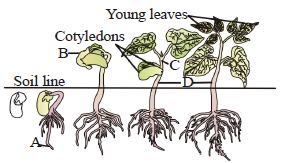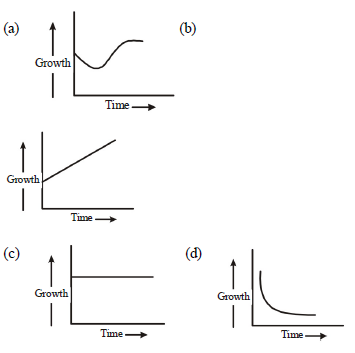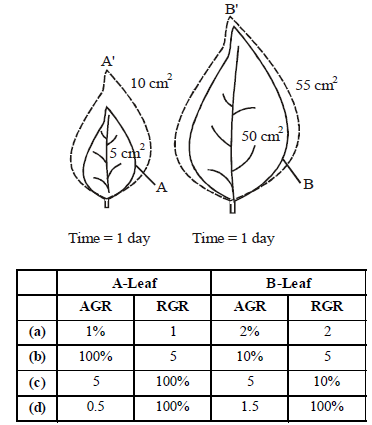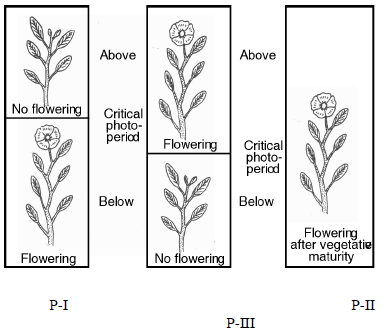Please refer to Plant Growth and Development Class 11 Biology Important Questions with solutions provided below. These questions and answers have been provided for Class 11 Biology based on the latest syllabus and examination guidelines issued by CBSE, NCERT, and KVS. Students should learn these problem solutions as it will help them to gain more marks in examinations. We have provided Important Questions for Class 11 Biology for all chapters in your book. These Board exam questions have been designed by expert teachers of Standard 11.
Class 11 Biology Important Questions Plant Growth and Development
Objective Questions
Question. The correct sequence of the developmental process in a plant cell is
(a) Plasmatic growth, Differentiation, Senescence and Maturation respectively
(b) Plasmatic growth, Differentiation, Maturation and Senescence respectively
(c) Maturation, Plasmatic growth, Differentiation and Senescence respectively
(d) Differentiation, Plasmatic growth, Maturation and senescence respectively
Answer
B
Question. Which one includes growth inhibitors?
(a) ABA, Cytokinin
(b) GA, IAA
(c) ABA, C2H4
(d) None
Answer
C
Question. Which of the following growth regulators can fit either of the groups (promoter and inhibitor)
(a) C2H4
(b) ABA
(c) GA
(d) IAA
Answer
A
Question. Match the column
| Column – I | Column – II |
| A. C Darwin and F Darwin | I. Cytokinin |
| B. Miller and Skoog | II. ABA |
| C. F. W Went | III. C2H4 |
| D. Kurosawa | IV. Auxin |
| V. GA |
The Correct match is
(A) A – IV, B – I, C – I, D – III
(B) A – IV, B – I, C – III, D – V
(C) A – III, B – I, C – II, D – IV
(D) A – V, B – IV, C – II, D – I
Answer
B
Question. ABA was discovered during
(a) Mid 1960
(b) Mid 1906
(c) Mid 1966
(d) Mid 1967
Answer
A
Question. Who isolated auxin from coleoptile seedling for the first time?
(a) Darwin
(b) Miller
(c) Skoog
(d) F. W. Went
Answer
D
Question. Auxin was first isolated from
(a) Coleoptile of oat
(b) Human urine
(c) Maize
(d) Tez
Answer
B
Question. Which of the following statements is correct?
(a) IAA and IBA are natural but NAA. 2,4-D and 2,4,5-T are synthetic auxins
(b) IAA and NAA are natural but IBA 2.4, 5-T and 2.4-0 are synthetic auxins
(c) NAA and 2,4,5-T are natural but IAA IBA and 2,4-0 are synthetic hormones
(d) IAA NAA IBA 2,4-D and 2,4,5-T are synthetic auxins
Answer
A
Question. The hormone responsible for phototropismis is
(a) Auxin
(b) C2H4
(c) ABA
(d) GA
Answer
D
Question. The phenomenon of apical dominance is strengthened by
(a) Removal of the tip
(b) Removal of loves
(c) Auxin production
(d) Production of fruits
Answer
C
Question. Senescence in plants can be promoted by applying.
(a) auxins
(b) cytokinins
(c) GA
(d) ethylene
Answer
D
Question. Presence of which of the following compound accelerates abscission of flower and fruits?
(a) Acetaldehyde
(b) Ethephon
(c) Ascorbic acid
(d) Zeatin
Answer
B
Question. Which of the following hormone closes stomata in response to water stress?
(a) IAA
(b) ABA
(c) NAA
(d) GA3
Answer
B
Question. The movement of plant and its parts in response to light is called
(a) photorespiration
(b) photosynthesis
(c) phototropism
(d) photophosphorylation
Answer
C
Question. The essential distinction between long-day and shortday plants is that flowering in long day plants is promoted only when the day length exceeds a certain duration, called the ______________.
(a) critical day length
(b) short-long day length
(c) long-short day length
(d) photoperiod
Answer
A
Question. Day neutral plants relate to
(a) loss of activity during day time.
(b) flowering in all possible photoperiods.
(c) overactive during day time.
(d) no flowering in any photoperiods.
Answer
A
Question. Seed dormancy
(a) is the temporal delay to the process of germination.
(b) is the permanent delay to the process of germination.
(c) minimizes seedling survival by preventing germination.
(d) occurs due to the presence of growth inhibitors only.
Answer
A
Statement Type Questions
Question. Identify the correct and incorrect statements from the following.
(i) 17,500 new cells are produced per hour by a single maize root apical meristem.
(ii) With the help of length, growth of pollen tube is measured.
(iii) The growth of the leaf is measured in terms of volume.
(iv) Cells in a watermelon may increase in size by upto 3,50,000 times.
(a) (i), (ii), (iii) are correct and (iv) is incorrect.
(b) (i), (ii), (iv) are correct and (iii) is incorrect.
(c) (ii), (iii) are correct and (i), (iv) are incorrect.
(d) (i), (iv) are correct and (ii), (iii) are incorrect.
Answer
B
Question. Which of the following statements are correct ?
(i) Cytokinins promote senescence.
(ii) Auxins control apical dominance.
(iii) Gibberellins promote shoot elongation.
(iv) Abscissic acid enables seeds to withstand desiccation.
(a) (i) and (ii) only
(b) (ii) and (iii) only
(c) (i) and (iii) only
(d) (ii), (iii) and (iv) only
Answer
D
Question. Read the following statements (i-iv) regarding“ethephon” and answer the question which follows them.
(i) Ethephon is sprayed in aqueous solution and is readily absorbed and transported within the plant.
(ii) It hastens fruit ripening in tomatoes and apples.
(iii) It can be used to induce fruit thinning in cotton, cherry and walnut.
(iv) It is used to promote female sex expression in cucumber and increase yield.
How many of the above statement(s) is/ are correct?
(a) One
(b) Two
(c) Three
(d) All
Answer
D
Matching Type Questions
Question. Match the plant hormones given in column I with their function/other name given in column II and choose the correct combination.
| Column -I (Plant hormone) | Column -II (Function/other name) |
| A. Zeatin | I. Flowering hormone |
| B. Florigen | II. Synthetic auxin |
| C. IBA | III. Cytokinin |
| D. NAA | IV. Natural auxin |
(a) A – III; B – IV; C – I; D – II
(b) A – II; B – I; C – IV; D – III
(c) A – I; B – II; C – III; D – IV
(d) A – III; B – I; C – IV; D – II
Answer
D
Question. Match the plant hormones listed in column-I with their major role listed in column-II. Select the correct option from the codes given below.
| Column-I | Column-II |
| A. Auxin | I. Fruit ripening |
| B. Cytokinins | II. Apical dominance |
| C. Abscisic acid | III. Antagonistic to GAs |
| D. Ethylene | IV. Stomatal opening and closing |
| V. Growth of lateral buds |
(a) A – IV; B – V; C – III; D – I
(b) A – II; B – IV; C – III; D – 1
(c) A – II; B – V; C – III; D – I
(d) A – III; IV B – V; C – II; D – I
Answer
C
Question. Match Column-I (Discovery) and Column-II (Scientists) and select the correct option.
| Column – I (Discovery) | Column – II (Name of scientists) |
| A. Foolish seedling disease of rice | I. Cousins |
| B. Crystallized the Kinetic | II. F.W. Went |
| C. Release of ethylene gas | III. Skoog and Miller |
| D. Bioassay of Auxin | IV. E. Kurosawa |
(a) A – III; B – IV; C – I; D – II
(b) A – IV; B – III; C – II; D – I
(c) A – IV; B – III; C – I; D – II
(d) A – IV; B – I; C – III; D – II
Answer
C
Question. Which one of the following pairs is not correctly matched?
(a) Abscisic acid — Stomatal closure
(b) Gibberellic acid — Leaf fall
(c) Cytokinin — Cell division
(d) IAA — Cell wall elongation
Answer
B
Question. Which one of the following is incorrectly matched?
(a) IAA – Indole compound
(b) GA – Terpenes
(c) ABA – Carotenoid derivatives
(d) C2H4 – Adenine derivatives
Answer
D
Diagram Type Questions
Question. The given diagram represents the germination and seedling development in beam.

Identify A, B, C and D marked in the given figure.
| A | B | C | D | |
| (a) | Plumule | Cotyledons | Hypocotyl | Epicotyl |
| (b) | Radicle | Seed coat | Epicotyl | Hypocotyl |
| (c) | Hypocotyl | Cotyledons | Epicotyl | Root hair |
| (d) | Root hair | Cotyledons | Plumule | Hypocotyl |
Answer
B
Question. Which of the following shows the correct graph of arithmetic growth?

Answer
B
Question. The given figure shows the comparison of growth rate of two leaves (A and B) over the period of one day. Both the leaves A and B have increased their area in a given time to produce A’ and B’ leaves respectively. If AGR = absolute growth rate and RGR = relative growth rate, then select the correct option.

Answer
C
Question. The picture below shows three different types of plants (marked as P-I, P-II and P-III) which flower on the basis of their critical photoperiod. Now identify these plants (P-I, II and III).

(a) P-I = Long day plant; P-II = Short day plant; P-III = Day neutral plant
(b) P-I = Short day plant; P-II = Long day plant; P-III = Day neutral plant
(c) P-I = Short day plant; P-II = Short day plant; P-III = Day neutral plant
(d) P-I =Long day plant; P-II = Long day plant; P-III = Day neutral plant
Answer
B
Critical Thinking Type Questions
Question. Which of the following points is shown by cell at the root or shoot apex ?
(a) Rich in protoplasm, possesses large conspicuous triploid nucleus.
(b) Cell wall is cellulosic, primary in nature and with abundant plasmodesmata.
(c) Rich in protoplasm with large conspicuous nucleus.
(d) Both (b) and (c).
Answer
D
Question. Arithmetic growth is expressed as
(a) Lt = L0 + rt
(b) L0 = L0 + rt
(c) W1 = W0 ert
(d) W0 = W1 ert
Answer
A
Question. Absolute growth rate is defined as the
(a) synthesis of new intercellular and extracellular materials.
(b) measurement & the comparison of total growth per unit time
(c) growth of the given system per unit time.
(d) increased growth per unit time.
Answer
B
Question. A primary root grows from 5 cm – 19 cm in a week.
Calculate the relative growth rate over the period.
(a) 20%
(b) 40%
(c) 60%
(d) 80%
Answer
B
Question. Which of the following represents the correct sequence of the development process in a plant cell?
(a) Cell division → Elongation → Senescence →Maturation
(b) Meristematic cell → Maturation elongation → Death
(c) Cell division → Elongation → Maturation → Plasmatic growth
(d) Cell division → Differentiation → Maturation →Senescence
Answer
D
Question. Experiments done by Charles Darwin and his son on plant phototropism showed that
(a) auxin is produced in the tip of the coleoptile.
(b) the tip of the coleoptile is the light receptor of the plant.
(c) within coleoptiles, auxin moves laterally away from the source of the light.
(d) more cell elongation takes place on the shaded side of the plant.
Answer
B
Question. Skoog and Miller stimulated cell division in tobacco plant with degraded DNA. The active ingredient in stimulants, which resembles cytokinins, was modified
(a) adenine
(b) auxin
(c) terpenes
(d) carotenoids
Answer
A

